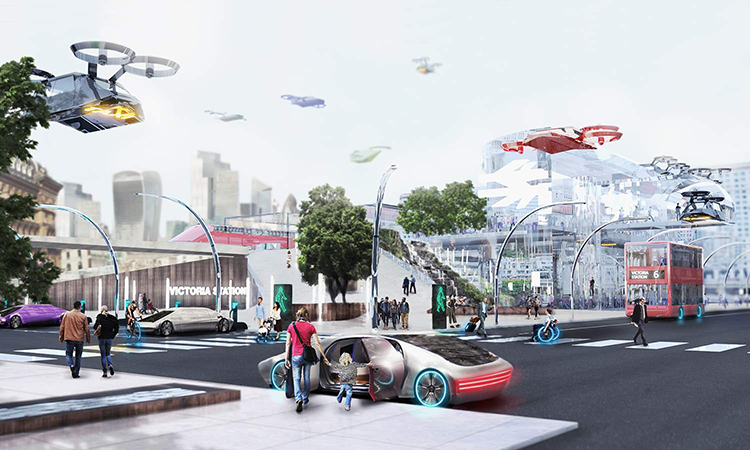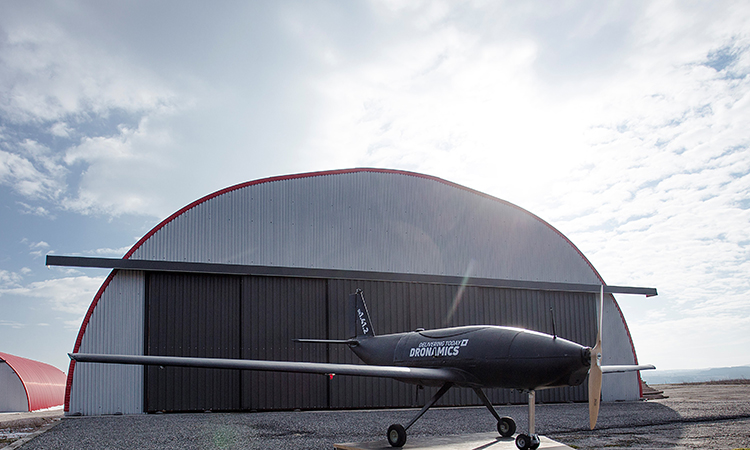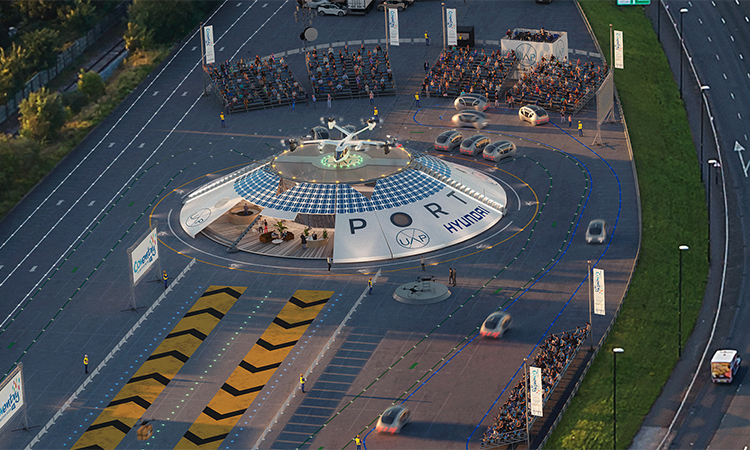Investing in new aviation systems to secure the future of the industry
- Like
- Digg
- Del
- Tumblr
- VKontakte
- Buffer
- Love This
- Odnoklassniki
- Meneame
- Blogger
- Amazon
- Yahoo Mail
- Gmail
- AOL
- Newsvine
- HackerNews
- Evernote
- MySpace
- Mail.ru
- Viadeo
- Line
- Comments
- Yummly
- SMS
- Viber
- Telegram
- Subscribe
- Skype
- Facebook Messenger
- Kakao
- LiveJournal
- Yammer
- Edgar
- Fintel
- Mix
- Instapaper
- Copy Link
Posted: 11 March 2021 | Gary Cutts, Leah Hockley (International Airport Review) | No comments yet
Gary Cutts, Challenge Director of the UK Research and Innovation’s (UKRI) Future Flight Challenge, spoke to International Airport Review’s Junior Editor, Leah Hockley, about the purpose of the challenge and how it is working to encourage innovation within the industry, as well as the importance of the development of future flight systems.


Credit: UK Research and Innovation (UKRI)
Can you please give us a brief overview of the purpose of the Future Flight Challenge?
The Future Flight Challenge is a UK government-supported programme that is working to develop the wide variety of new aviation systems that are required to allow new classes of air vehicles to come into being.
Rather than just funding the vehicles, we’re funding all aspects of the system, with the belief that all of these new aviation systems are interconnected”
It is very much taking an aviation system approach rather than an aerospace approach. So, rather than just funding the vehicles, we’re funding all aspects of the system, with the belief that all of these new aviation systems – from air traffic management (ATM) to infrastructure and regulation – are interconnected. So, we’re bringing the industry together to drive those new aviation systems for these new classes of vehicle.
The vehicles that we’re talking about cover three broad areas. Firstly, drones from the relatively small 10kg to 20kg class, all the way up to substantial freight-carrying unmanned air vehicles in the multiple-tonne class. Secondly, we also consider Advanced Air Mobility vehicles; typically three-to-five-person passenger-carrying electric vehicles, often with vertical take-off capabilities. Finally, the third class of vehicle is more conventional aircraft, something typically up to 19 seats, but with electric or hydrogen power systems. In each case, the vehicles require far-reaching developments in the supporting aviation system.
A wide range of projects have received funding from the scheme. What kind of technology is being researched and tested within these projects?
As I said in the outset, the Future Flight Challenge is looking at the innovation of aviation systems with the view that the whole system has to be dealt with in an integrated fashion. The breadth of things that we see that need to be changed or have opportunities for improvement are pretty broad.
So, regarding drones and mobility vehicles, there’s clearly a need for regulation to be developed. Both regulation for the vehicles themselves, but also, particularly, operational regulation. That’s something that we’re working very closely with the UK Civil Aviation Authority (CAA) on. They are a cardinal partner in the programme, and we work with them to ensure early identification of the need for new regulation. The CAA’s approach to innovation is a real, competitive advantage for the UK.


Credit: AGS Airports
The second thing that we’re looking at is air traffic management (ATM) systems. I think that it’s pretty obvious that, when we talk about these new classes of vehicle, they’re going to perform new missions in new places at a much higher volume. Some of the use cases will bring us much closer into contact with urban environments. So, the air traffic management systems that we have today will not cope with that volume and complexity of operation. As a result, we’re working heavily on the development of new air traffic management technologies and systems, as well as how they can integrate with the current aviation system.
We’re working heavily on the development of new air traffic management technologies and systems, as well as how they can integrate with the current aviation system”
The third area is physical infrastructure concepts. So, equipping and flying hydrogen- and electric-powered classic air vehicles, but also the concepts of energy replenishment that we have in airports. How would we power or charge them? Are we talking rapid charging or battery swaps, or maybe other systems? If you look at the use cases of air mobility, people have a vision that they will land in small vertiport in city centres. So, what are the concepts for vertiports? What are the regulations, rules or needs of city centre vertiports?
So, clearly, there’s some really significant physical infrastructure development necessary here, and then we have look at the digital systems, as well. We believe that, over time, some degree of autonomy will be an enabler for these markets. It will not be essential at the start, but we will eventually see autonomy come into play. So, the concept of these vehicles and the missions that they’re operating on, being led by autonomous systems, clearly requires robust communication systems and secure digital platforms, as well as an appropriate level of cyber security and system redundancy.
Ultimately, we are looking to introduce new forms of aviation, and that will create a wide range of public reactions. We will have people for whom ‘flying taxis’ and drone deliveries just can’t come quickly enough – drawn in by the concept of new forms of transport and better connectivity. But other people will see this as being invasive technology, and there will be legitimate questions around noise or the case for safety, and then there are all kinds of other issues in there. So, we are also looking to work with people on the social considerations. We are very keen on supporting the demonstration of new systems through challenging, real-life use cases.
What are the benefits of the development of urban air mobility?
When I came into this role, people tended to talk about urban air mobility (UAM). However, it has sort of changed title now. In January 2021, people began to talk about advanced air mobility, or just air mobility. I think that there’s an increasing realisation that the types of vehicles that could perform an air taxi service in the city could be significantly more capable and provide a sub-regional air service. So, the question goes beyond the benefits of urban use to the benefits of a distributed, sustainable air service where, ultimately, prices will be very competitive with ground transportation. Put this way, the benefits seem clearer, but the real swinger is the quicker point-to-point journey times, which will be possible.
The question goes beyond the benefits of urban use to the benefits of a distributed, sustainable air service”
A key focus here is looking at whether you can develop much faster cross-city transit. So, speed is absolutely an essential thing, whilst still staying within the city limits. The main competitor here is ground- or underground-based transportation, but it’s more of a complete commute model. So, there is a case for a similar sized vehicle taking people from the outskirts of cities, maybe 20km away, and flying them into cities – and the obvious advantage there is speed.
However, what we’ve seen in the last couple of years is the possibility of there being another market: what you might call a town-to-town connector, where a three-to-five-person vertical take-off capable vehicle could be developed into something like a 12-seater with some kind of vertical take-off capability, and it is conceivable that you could imagine travelling over a distance of a 100km to 150km range relatively quickly.
So, that kind of vehicle – which is sustainable and has very low operating costs, with vertical take-off or near vertical take-off capabilities – gives you the ability to connect relatively small population centres by aircraft, as well. This is a market that we are investigating right now: what is the use case for connecting more modest towns that today often have no air transit capability? Can we create a case for that? How do you connect places that are difficult to connect? Can we give them a way to increase their economic advantage by being able to connect without having to go through a complex route or metal network? There is significant socio-economic value for something like that.


Credit: Urban Air Port
How will Urban Air Port’s Air-One site and any of the other Future Flight Challenge-funded projects support the decarbonisation of aviation and transport as a whole?
This is a new set of markets: It is aviation on a smaller scale, more localised, but still part of the larger aviation system, and we want there to be significant societal value. Whether it be connecting difficult to connect communities, providing better and faster transport or providing the start of the zero-carbon aviation system. We think that there’s a wide range of societal benefits, and we want to be able to highlight the socio-economic case for this new form of aviation.
The industry is taking seriously its commitment to decarbonise, but we know that it is incredibly technically challenging, and also requires the entire aviation system to take part”
The industry is taking seriously its commitment to decarbonise, but we know that it is incredibly technically challenging, and also requires the entire aviation system to take part – whether that’s using new fuels or adopting new technology to optimise flight, as well as all of the other system changes – like infrastructure – that come with that. So, it’s a great challenge to decarbonise, and one of our beliefs is that, in helping the new aviation industry that’s being developed come into being quickly, we are able to only fund either vehicles that are already zero-carbon or will very quickly become zero-carbon: what we are doing is helping to accelerate the systems that will allow these new zero-carbon aircraft to come into being.
I would like to emphasise that every aspect of the aviation industry, as we see it, has real innovation opportunities. It is a high-tech industry in every regard, from airport infrastructure to digital communications, to air traffic management, as well as aircraft.
I think, in order to both provide new forms of aviation, but also to drive the sustainability agenda, we need the aviation industry to increasingly work together on large-scale innovation. One of the real benefits that we’ve seen in the Future Flight Challenge is that it has brought all of those different elements of the aviation industry into quite a tightly knit consortia, and we get to see a massive sharing of ideas, concepts and, frankly, visions about how to drive the aviation industry forward.
Gary Cutts is the Challenge Director of the UK’s Future Flight Challenge. He has 30 years’ experience in the aviation industry, mainly working on complex engineering systems, but with experience in business development, customer consultancy and services creation. Cutts has held engineering leadership positions in Rolls Royce, working across the product lifecycle, covering technology acquisition, concept definition, development/certification and service management. He has also held many global, executive leadership positions for the Group, including creating the system design function and leading the digital transformation of engineering. He is now leading the UK government’s Future Flight innovation programme. Cutts’ passion is to bring teams together to challenge the status quo and drive step changes in both the technology and business thinking to transform the future of the aviation industry.
Related topics
Air freight and cargo, Air traffic control/management (ATC/ATM), Aircraft, Airport construction and design, Airside operations, Drones, Emissions, Engineering, Funding and finance, New technologies, Passenger experience and seamless travel, Regulation and Legislation, Safety, Security, Sustainability, Sustainable development
Related organisations
Civil Aviation Authority (CAA), UK Research and Innovation (UKRI), Urban Air Port


















